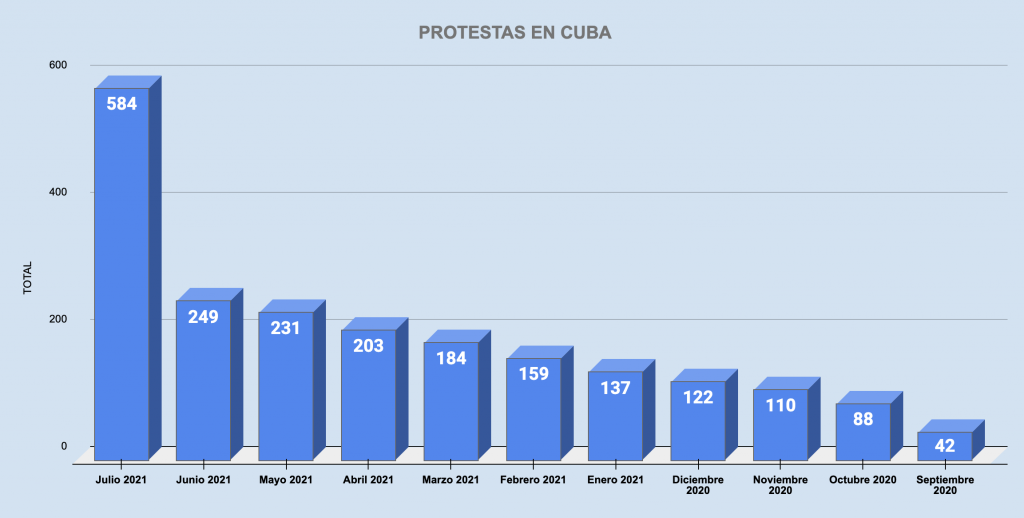A study of dissident activity revealed that over 187,000 Cuban citizens participated in protests against the communist regime in July, most of them taking the streets during the nationwide July 11 marches calling for the end of the regime, the independent outlet Cubanet reported Monday.
The Cuban Conflict Observatory (OCC), a non-governmental organization, tracks monthly protest activity on the island and noted a significant spike in public assemblies against communism — which are illegal in the country — between June and July, but that spike is a part of a larger trend on more frequent protests that began long before this year. The OCC noted that the scale of the protests on the island is unprecedented in the history of the Republic of Cuba, founded in 1902, and significantly larger than any protest activity against former presidents Fulgencio Batista and Gerardo Machado.
The July 11 protests occurred in at least 40 different municipalities nationwide, touching every corner of the island. The protests were mostly peaceful, consisting of marches in which protesters chanted pro-democracy and anti-communist slogans. Protesters shared videos online showing police attacking large groups of protesters who appeared to be engaging in non-violent activity, using gang beatings to intimidate participants into going home and, on some occasions, appearing to open fire using live ammunition into unarmed crowds.
President Miguel Díaz-Canel, who serves merely as a figurehead for the Castro regime, delivered a speech on July 11 in which he encouraged civilians to physically assault suspected dissidents, declaring it an “order of combat” for “revolutionaries.”
The Castro regime has since severely limited internet access on the island, preventing Cuban citizens from sharing live or recent images of the situation.
The OCC noted in its report for July that Cuba has experienced over 100 protests nationwide every month between July and November 2020, when a group of artists and other intellectuals stormed the headquarters of the Ministry of Culture in Havana. This means every month in 2021 so far has witnessed over 100 protests. Cubans have organized dozens of protests every month for years, however, according to OCC statistics, showing that protests in Cuba are not, as many establishment American media outlets reported last month, unprecedented in any way.
“The most important thing this month,” the OCC said of July, “was not the increase in the number of protests, but the massive nature of the participation. This represents a 11687-percent increase.”
The number of individual Cubans taking the streets increased from 1,600 in June to 187,000 in July. The study noted that the vast majority of those took the streets between July 11 and 12 and confirmed that 49 regional capitals experienced large-scale protests that weekend.
The OCC documented 584 protests in the past month, compared with 249 in June, showing a more modest increase in protest activity. The July statistic represents about 18 protests a day, compared to eight a day in June. Between September 2020 and July 2021, the other large increase in the number of protests occurred between October and November — 88 protests in October compared to 110 protests the month after.

Source: Cuban Conflict Observatory
Hundreds of people in Havana peacefully assembled outside of the Ministry of Culture in Havana in November in defense of the San Isidro Movement, an artist collective whose members had gone on hunger strike to protest limits of artistic rights on the island. The Castro regime regularly imprisons writers, musicians, and other artists for “counterrevolutionary” activity, but more recently passed a law that made it illegal to draw, film, compose, or otherwise create anything that can be defined as art without first getting a permit from the Ministry of Culture. The November protests led to repeat incidents in front of the Ministry of Culture, in June, an independent journalist filmed the minister of culture himself, Alpidio Alonso, physically assaulting another journalist at one such event.
The recent look at the anti-communist movement in Cuba highlights increased willingness on the part of average citizens to defy the regime. It excludes decades of history of peaceful protest on the island, however, including weekly protests by a group called the Ladies in White — a collective of the wives, daughters, mothers, and other female relatives of political prisoners — since 2003. The largest dissident group on the island, the Patriotic Union of Cuba (UNPACU), has also organized regular protests that have attracted hundreds of people, most recently nationwide protests against communism in September 2019 in honor of the feast day of the patron saint of the country, Our Lady of Charity. The head of UNPACU, José Daniel Ferrer, has been missing since July 11; his family at press time has no information of his whereabouts, even though no evidence exists he participated in the protests that day.
Ferrer is believed to be among thousands of Cubans imprisoned or missing since July 11. Initial reports estimated that the true number of people disappeared by police was around 5,000, but police has complicated the confirmation of arrests through shutting down the internet, making it more difficult for dissidents to contact international human rights organizations, and imprisoning or otherwise silencing the mothers and relatives of missing protesters. Another Cuban human rights group, the Cuban Observatory for Human Rights (OCDH), revealed that it had confirmed that 1,004 people were arrested or declared missing since July 11 as of August.

COMMENTS
Please let us know if you're having issues with commenting.